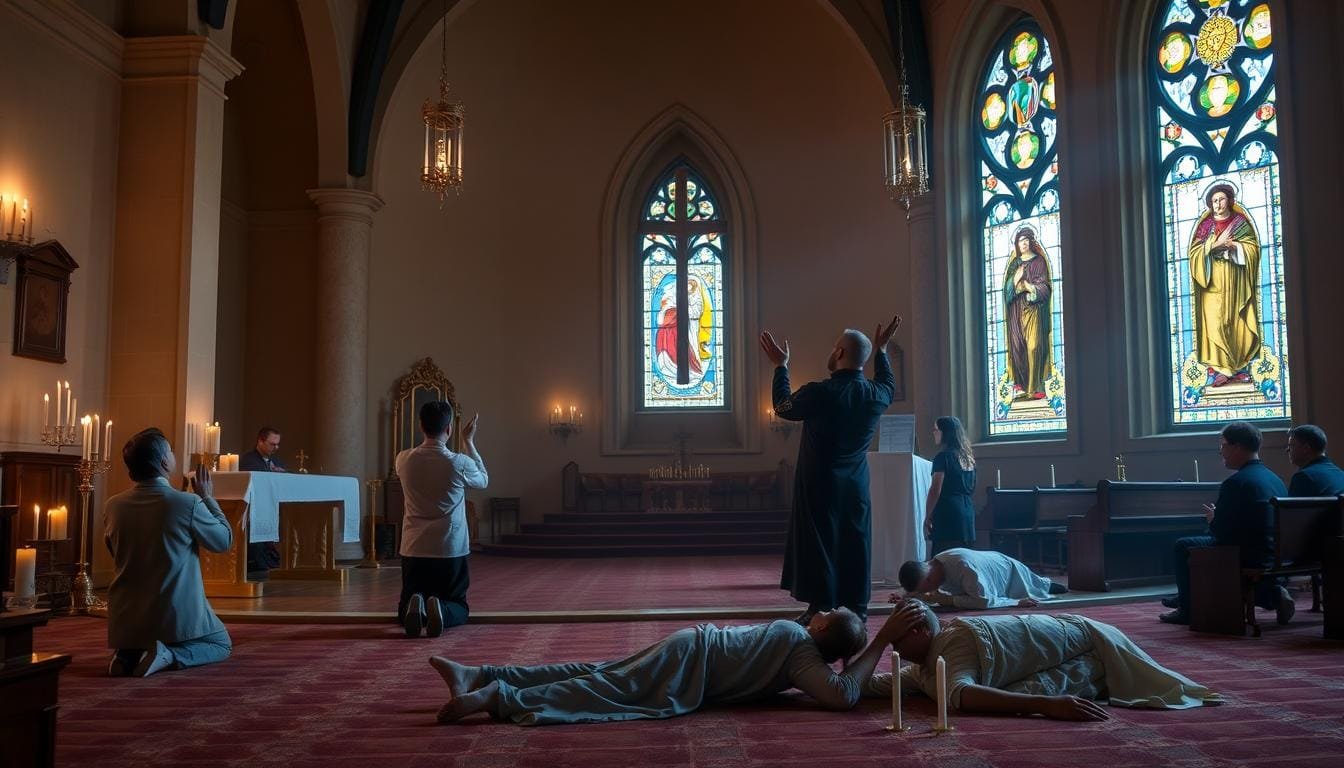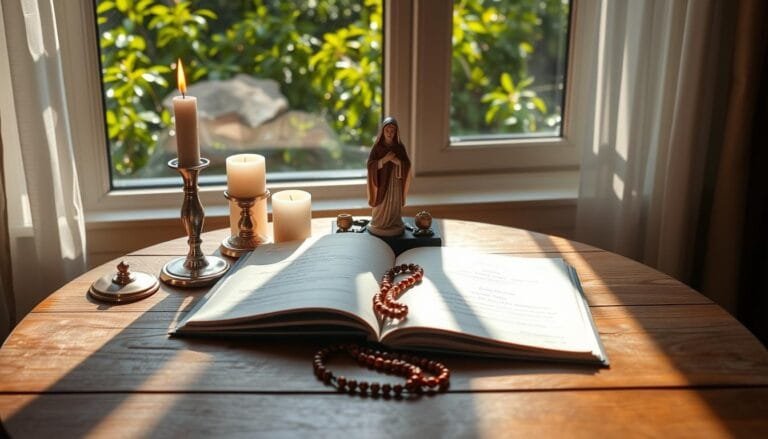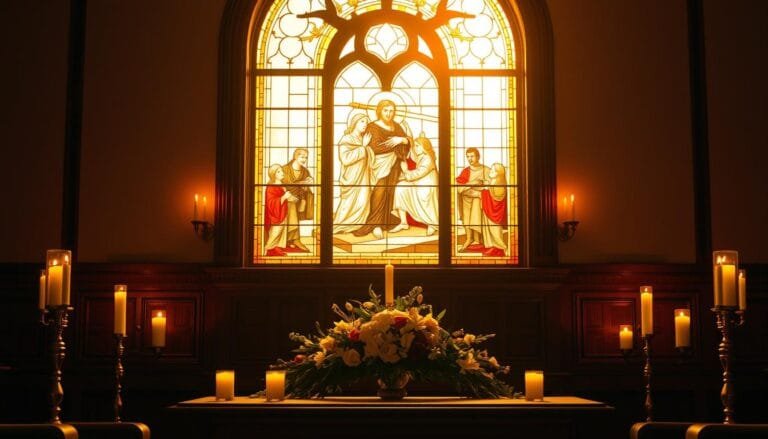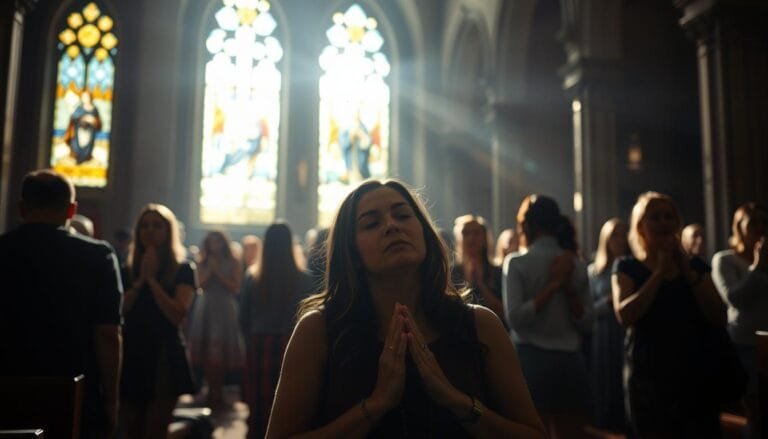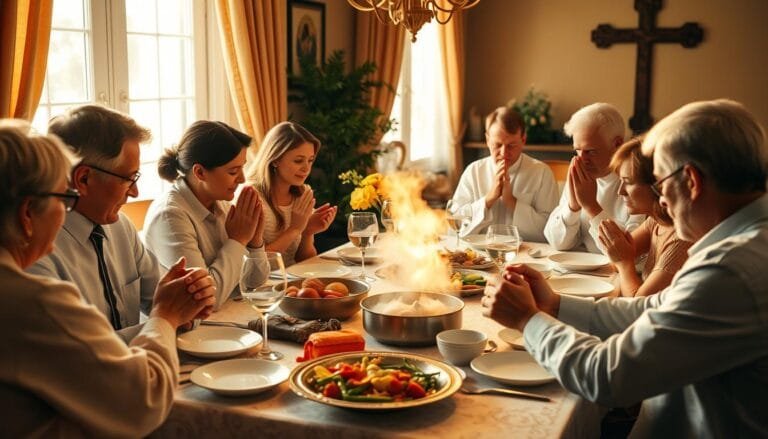Catholic Prayer Postures: Traditional Gestures of Devotion
This website contains affiliate links. As an Amazon Associate, I earn from qualifying purchases. The content on this website was created with the help of AI.
Catholic prayer postures change during Mass for a reason. These prayer postures are body language that expresses devotion. They convey meaning in ways words can’t match.
We kneel humbly, stand reverently, and sit thoughtfully. Each movement carries deep spiritual significance. These gestures link us to centuries of faith.
During Mass, we move our bodies purposefully. We sit to listen and learn four times. We stand six times to show respect and readiness.
We kneel three times in deepest reverence. Every motion, from the sign of the cross to raised hands, has meaning.
In private prayer, our postures can strengthen our bond with God. Our bodies join our spirits in worship, whether standing, kneeling, or lying down.
Key Takeaways
- Catholic prayer involves the whole body, with specific postures for different parts of the Mass
- Sitting is for listening, standing for respect, and kneeling for devotion
- Prayer postures are rooted in biblical examples
- The sign of the cross and genuflection are important Catholic gestures
- Private prayer can benefit from the conscious use of different postures
- Singing and responding during Mass are forms of active participation
Understanding Catholic Prayer Postures and Their Sacred Meanings
Catholic prayer postures are powerful liturgical signs. They express faith through body language in prayer.
These gestures embody a deep spiritual connection between the physical and the divine.
In Catholic worship, we use various postures to engage our entire being. Standing shows respect and readiness.
Kneeling represents adoration and submission. Sitting allows for attentive listening and meditation during Mass.
The significance of these postures is reflected in the following statistics:
- 90% of prayer involves being physically present in a designated space
- Standing is the designated posture for receiving Communion in the United States
- Bowing has been determined as the sign of reverence before receiving Communion
Our body language in prayer includes meaningful gestures beyond postures. These gestures add depth to our spiritual practice.
| Gesture | Meaning | When Performed |
|---|---|---|
| Sign of the Cross | Affirmation of faith | Beginning and end of Mass |
| Striking the breast | Repentance | During the Confiteor |
| Exchange of Peace | Reconciliation and unity | Before Communion |
Understanding these Catholic gestures deepens our participation in Mass. It enriches our personal prayer life.
These physical expressions of faith unite us and foster a deeper connection with God.
The Significance of Kneeling in Catholic Worship
Kneeling prayer is vital in Catholic worship. It symbolizes devotion, humility, and submission to God’s will. This powerful posture plays a crucial role in the Mass.
Kneeling as an Act of Submission and Reverence
In Catholic tradition, kneeling shows our acceptance of God’s sovereignty. It’s a physical sign of spiritual surrender. We humble ourselves before God, showing respect and adoration.
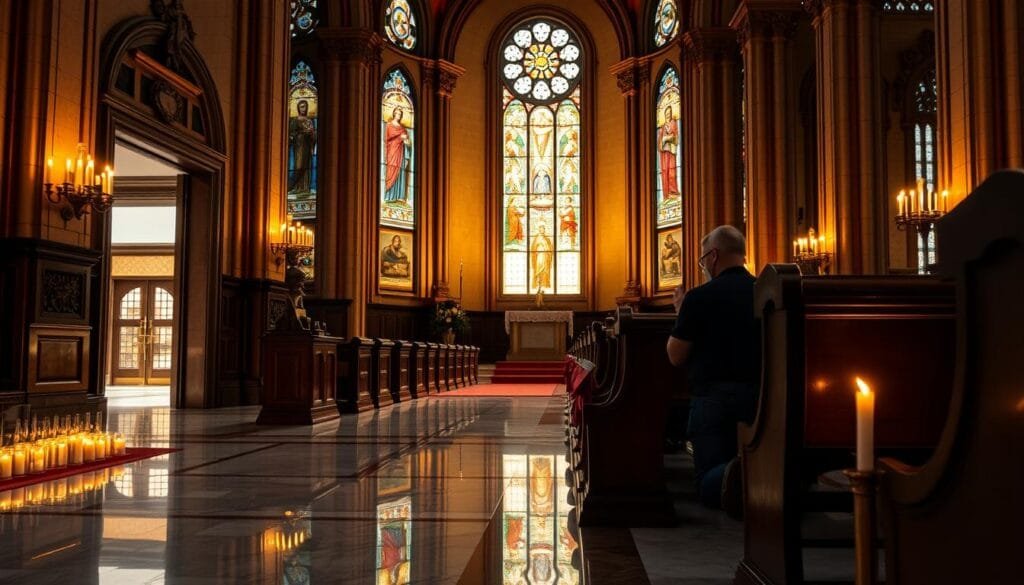
When to Kneel During Mass
Catholics kneel at key moments during the liturgy. These include the Eucharistic prayer and after receiving Communion. Kneeling also occurs during genuflection at the Eucharist.
- The Eucharistic prayer
- After receiving Communion
- During genuflection at the Eucharist
These acts of kneeling show reverence for Christ’s presence in the Eucharist.
Biblical Foundations of Kneeling Prayer
Kneeling in prayer has deep roots in Scripture. Jesus knelt in Gethsemane, and many Psalms encourage kneeling before God. The New Testament shows apostles kneeling in prayer too.
| Biblical Figure | Reference | Context of Kneeling |
|---|---|---|
| Solomon | 1 Kings 8:54 | Dedication of the Temple |
| Daniel | Daniel 6:10 | Daily prayer |
| St. Stephen | Acts 7:60 | Before his martyrdom |
| St. Peter | Acts 9:40 | Before raising Tabitha |
Kneeling in Catholic worship links us to this rich biblical history. It reminds us of our place before God. This practice opens our hearts to His presence.
Standing Postures in Catholic Liturgy
Standing plays a crucial role in Catholic liturgy. This posture symbolizes respect, readiness, and belief. We stand at key moments during Mass, showing our alertness to God’s word.
Standing as a Sign of Respect and Readiness
In Catholic worship, standing is a powerful expression of faith. It shows our readiness to respond to God’s call. This posture has strong biblical roots and Jewish traditions.
Key Moments for Standing During Mass
During Catholic Mass, we stand at several important times:
- The opening prayer
- Gospel reading
- Recitation of the Creed
- The Lord’s Prayer
- Prayers of the Faithful
- Processions at the start and end of Mass
Spiritual Significance of Standing in Prayer
Standing in prayer carries deep spiritual meaning. It mirrors our reaction to wonderful experiences. In liturgy, standing signifies our prayers being lifted to God.
This posture increases our alertness and focus. It helps us engage more fully in worship. Standing represents our active participation and readiness to serve God.
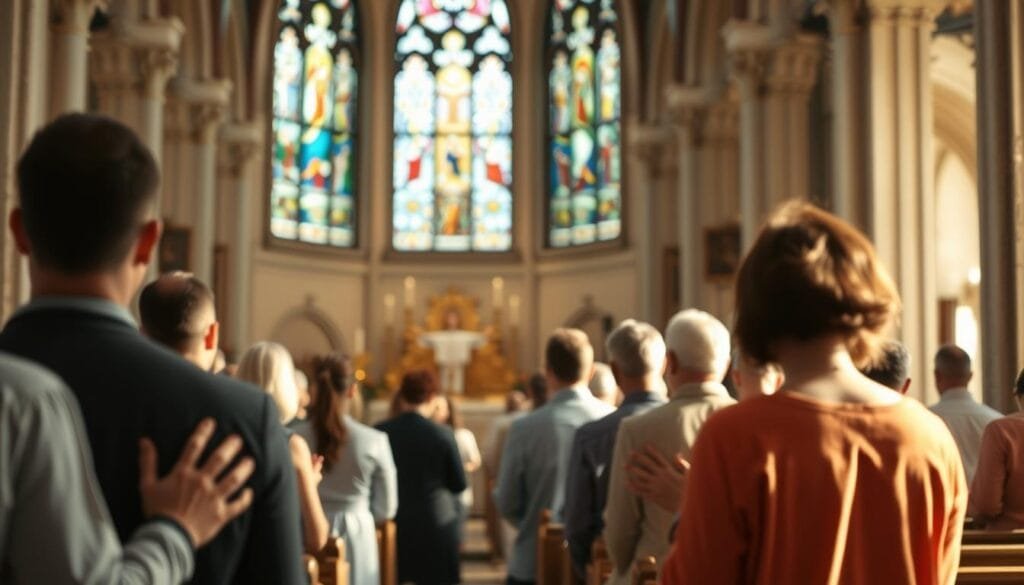
Catholic Prayer Postures: Sitting and Prostration
Catholic prayer postures express devotion and engage the body in worship. Sitting and prostration are two important postures with deep spiritual meaning.
They help believers connect with God in different ways.
Sitting is common during Mass, especially for readings and homilies. It allows for comfortable, sustained attention.
This posture is ideal for Catholic meditation. Many find it helpful for reflection and contemplation in personal prayer.
Prostration represents complete submission and humility. It involves lying face down on the ground. This posture symbolizes death to self and rebirth into service.
Prostration is seen during ordination ceremonies and Good Friday services.
Both sitting and prostration have biblical roots. They engage the body in different aspects of worship. Let’s explore their significance:
| Posture | Meaning | Usage |
|---|---|---|
| Sitting | Receptiveness, reflection | Mass readings, personal prayer |
| Prostration | Submission, humility | Ordinations, Good Friday |
Try these postures in your prayer life. Sit in quiet meditation or prostrate in humble adoration. Each posture can deepen your connection with God.
They can enrich your spiritual journey in unique ways.
Sacred Gestures and Body Language in Catholic Prayer
Catholic prayer involves many sacred gestures and body language. These actions express our faith physically. They connect our bodies and souls in worship.
The Sign of the Cross
The sign of the cross is crucial in Catholic prayer. It symbolizes our salvation, baptism, and devotion to Christ. We use it to start and end prayers, calling on the Holy Trinity.
Genuflection and Bowing
Genuflection shows respect to the Blessed Sacrament. We bend our right knee when passing the tabernacle. Bowing is another important action in Catholic worship.
We bow during the Creed and before receiving Holy Communion. These gestures express our reverence and devotion.
Hand Positions During Prayer
Hand positions in prayer have deep meaning in Catholic tradition. Folded hands show prayerfulness and humility.
The Orans gesture, with arms extended, represents openness to the Holy Spirit.
These postures help us engage fully in prayer. They involve our whole being in the act of worship.
Most Catholic prayer gestures involve standing. This emphasizes respect and readiness to follow God’s will. These actions form a non-verbal language of faith.
Private Prayer Postures for Personal Devotion
Personal prayer offers many ways to connect with God. We can create a sacred space at home for our devotion. Our home altar can be a focal point for prayer, offering comfort and spiritual focus.
Creating Sacred Space at Home
A home altar can turn any corner into a sacred space. This area helps us focus and deepen our spiritual connection. Add religious items, candles, or images that inspire you.
Combining Different Prayer Positions
In personal prayer, we can use various postures:
- Kneeling for humility and reverence
- Standing to show respect and readiness
- Sitting for extended periods of reflection
- Prostration for deep surrender and adoration
Changing positions during prayer can help keep us focused. It can also express different aspects of our talk with God.
Physical Comfort and Spiritual Focus
Prayer comfort is important for long devotions. However, some discomfort can be good for our spirit. It reminds us that we depend on God.
We can find a balance between physical ease and spiritual alertness. This helps us in our personal prayer practices.
Using different prayer postures can deepen our spiritual experience. Creating a sacred space at home enhances our personal prayer life.
Being mindful of our physical position strengthens our bond with God.
Conclusion
Catholic prayer practices blend spiritual growth with physical expressions. Kneeling, standing, and sitting each play vital roles in worship.
U.S. bishops guide our bodily engagement through specific postures for Communion and Eucharistic Prayer.
These postures are more than just customs in the Catholic tradition. They bridge our earthly selves to the divine through concrete actions.
Research suggests these practices can boost relaxation and emotional connection.
Prayer postures unite us as one body in Christ. They echo the words we sing and the silence we share. By adopting these gestures mindfully, we open ourselves to deeper spiritual experiences.
